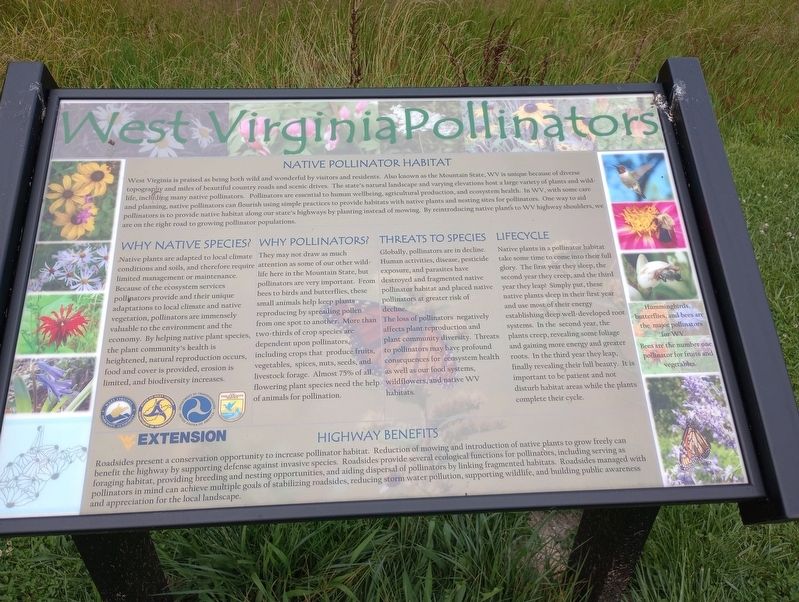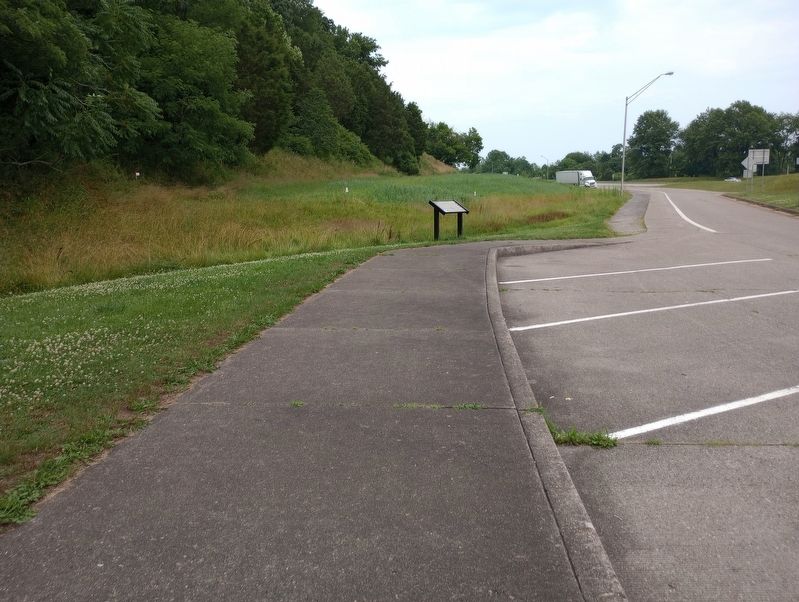Hurricane in Putnam County, West Virginia — The American South (Appalachia)
West Virginia Pollinators
Native Pollinator Habitat
West Virginia is praised as being both wild and wonderful by visitors and residents. Also known as the Mountain State, WV is unique because of diverse topography and miles of beautiful country roads and scenic drives. The state's natural landscape and varying elevations host a large variety of plants and wildlife, including many native pollinators. Pollinators are essential to human well being, agricultural production, and ecosystem health. In WV, with some care and planning, native pollinators can flourish using simple practices to provide habitats with native plants and nesting sites for pollinators. One way to aid pollinators is to provide native habitat along our state's highways by planting instead of mowing. By reintroducing native plants to WV highway shoulders, we are on the right road to growing pollinator populations.
Why Native Species?
Native plants are adapted to local climate conditions and soils, and therefore require limited management or maintenance. Because of the ecosystem services pollinators provide and their unique adaptations to local climate and native vegetation, pollinators are immensely valuable to the environment and the economy. By helping native plant species, the plant community's health is heightened, natural reproduction occurs, food and cover is provided, erosion is limited, and biodiversity increases.
Why Pollinators?
They may not draw as much attention as some of our other wildlife here in the Mountain State, but pollinators are very important. From bees to birds and butterflies, these small animals help keep plants reproducing by spreading pollen from one spot to another. More than two-thirds of crop species are dependent upon pollinators, including crops that produce fruits, vegetables, spices, nuts, seeds, and livestock forage. Almost 75% of all flowering plant species need the help of animals for pollination.
Threats To Species
Globally, pollinators are in decline. Human activities, disease, pesticide exposure, and parasites have destroyed and fragmented native: pollinator habitat and placed native pollinators at greater risk of decline.
The loss of pollinators negatively affects plant reproduction and plant community diversity. Threats to pollinators may have profound consequences for ecosystem health as well as our food systems, wildflowers, and native WV habitats.
Lifecycle
Native plants in a pollinator habitat take some time to come into their full glory. The first year they sleep, the second year they creep, and the third year they leap! Simply put, these native plants sleep in their first year and use most of their energy establishing deep well-developed root systems. In the second year, the plants creep, revealing some foliage and gaining more energy and greater roots. In the third year they leap. finally revealing their full beauty. It is important to be patient and not disturb habitat areas while the plants complete their cycle.
Highway Benefits
Roadsides present a conservation opportunity to increase pollinator habitat. Reduction of mowing and introduction of native plants to grow freely can benefit the highway by supporting defense against invasive species. Roadsides provide several ecological functions for pollinators, including serving as foraging habitat, providing breeding and nesting opportunities, and aiding dispersal of pollinators by linking fragmented habitats. Roadsides managed with pollinators in mind can achieve multiple goals of stabilizing roadsides, reducing storm water pollution, supporting wildlife, and building public awareness and appreciation for the local landscape.
Topics. This historical marker is listed in these topic lists: Animals • Environment • Horticulture & Forestry • Roads & Vehicles.
Location. 38° 26.992′ N, 82° 0.003′ W. Marker is in Hurricane, West Virginia, in Putnam County. Marker is on Interstate 64 east of Hurricane Creek Road (County Road 19), on the right when traveling west. The marker stands at the Hurricane Rest Area (Westbound). Touch for map. Marker is at or near this postal address: 335 I-64, Hurricane WV 25526, United States of America. Touch for directions.
Other nearby markers. At least 8 other markers are within 8 miles of this marker, measured as the crow flies. Hurricane Baptist Church / Hurricane Bridge Skirmish (approx. 2.6 miles away); Union Baptist Church (approx. 6.7 miles away); Red House (approx. 7.1 miles away); Harshbarger Corner (approx. 7.3 miles away); Mud River Covered Bridge (approx. 7.4 miles away); Battle of Scary (approx. 8 miles away); Putnam County / Kanawha County (approx. 8 miles away); a different marker also named Battle of Scary (approx. 8.1 miles away).
Additional commentary.
1. About the marker
This sign shares the history of how human interaction has affected populations of pollinator species, for better and for worse and thus serves as a historical marker for the purposes of the database.
— Submitted August 20, 2023, by Devry Becker Jones of Washington, District of Columbia.
Credits. This page was last revised on August 20, 2023. It was originally submitted on August 9, 2023, by Craig Doda of Napoleon, Ohio. This page has been viewed 69 times since then and 17 times this year. Photos: 1, 2. submitted on August 9, 2023, by Craig Doda of Napoleon, Ohio. • Devry Becker Jones was the editor who published this page.

